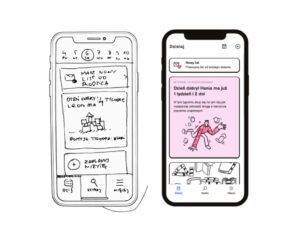Technology and healthcare go hand in hand to improving patient wellbeing. When thinking about patient care and satisfaction, we must go beyond the standards of treatment efficacy and operational efficiency. It’s not simply about minimizing the average length of stay, wait times, or even cost. Instead, patient care should be about whether the patient really feels cared for, as he or she navigates the healthcare system. Does the patient feel secure? Does the patient trust the healthcare system? Let’s take a walk in the shoes of a patient in the UAE to understand more.
Nadia has been feeling under the weather for a while now. She looks up her symptoms online to assess what might be wrong with her. As her symptoms get more defined and as she reads more, she begins to worry. Should she go see a doctor? Who should she see? How much will it cost? She gets busy at work and puts off making a decision. Nadia’s symptoms progress and she now speaks about it with her mother and a close friend.
They both present their hypotheses and reach out to their networks to find a suitable doctor. Nadia looks up two doctors at a clinic and hospital respectively but is concerned about whether her insurance plan will cover out-patient consultations for those providers, if at all. She calls the clinic, the receptionist quickly books her in for a consultation, but is unable to check her insurance status over the phone. Nadia calls the hospital and an automated system greets her. After a few tries to speak with a patient support representative, she hangs up.
In the UAE, there is a significant delay in patients presenting to doctors, especially those experiencing symptoms of non-communicable diseases. There are various factors for this delay. Hectic work culture and lack of a clear access pathway find patients putting off seeking care. Too many providers, combined with the complicated insurance processes, results in people delaying the necessary research and decision making. While insurance is mandatory, many have policies that only finance emergency care, not primary care or specialist visits. Advances in technology and healthcare innovation can help limit these delays. Blue-collar workers, who make up a majority of the population, are at a particular disadvantage. The disparity between their income and average healthcare costs is dramatic.
Paying out of pocket would be near to impossible for them. Many wait for annual screening camps and free medical check-up events. Some may not attend out of fear of finding a problem and not being able to afford treatment. Of course, this results in a constant peripheral feeling of stress and helplessness. They know they need to do something, but they’re unsure about what and how. This delay only gets worse if the patient is unaware of the need to seek care. Overall, the average prospective patient is hesitant and unclear about how to enter the healthcare ecosystem.
Nadia is now in discomfort and is ready for diagnosis and treatment. She has deeply researched her symptoms and full of questions for the doctor. On the day of her appointment, she reaches the clinic and finds that it doesn’t accept her insurance. Given the delay, her discomfort, and having taken the day off from work to see a doctor with a good reputation, she decides to pay out of pocket and proceed with the consultation.
After taking her vitals and history, the nurse escorts her to meet with the physician, who patiently listens and answers Nadia’s questions. He requests that she complete a few investigations urgently. Nadia visits a diagnostic center and her reports will be directly sent to the referring physician within 2-3 days.
The UAE’s population is predominantly floating, which is to say both patients and doctors are constantly changing. Despite strides in technology and healthcare access improvements, word of mouth is the key channel for people to find a physician. Patients are most comfortable with physicians of the same nationality — a unique factor of patient decision making in the UAE. They also look into the country of education/training and the number of years in the UAE. Patients in the UAE predominantly follow a physician over the provider or brand. They feel safer and trust the person over the institution. Their only constraint against selecting their doctor of choice is their insurance coverage. While patients prefer going to a provider nearby, they are willing to travel long distances for recommended clinics.
Besides, word of mouth, other channels include online forums, radio talk shows, medical camps, other events, and digital marketing. Digital marketing plays an important role for patients interested in cosmetic, dental, and other voluntary procedures. These marketing campaigns entice patients with the visual results of the treatments and of course, online discounts.
A majority of patients call or message via WhatsApp to make appointments. This small change in technology an healthcare scheduling closes the distancce between doctor and patient. They call the first number available to them and they prefer a ‘live’ conversation and confirmation. Human interaction at this point is fundamental for building trust with a prospective patient. Knowledgeable and timely answers about the patient’s concerns, whether logistical or clinical, is critical
Live interactions are also important if for whatever reason the clinician the patient is calling for is unavailable; the provider has the opportunity to appropriately schedule the patient for another doctor, by maybe offering a free consultation in order to not only secure the patient, but also to show true concern for the patient’s well-being by mitigating delay in presentation.
The patient’s first interaction with a provider is at the reception, where many activities tend to transpire, including check-in, registration, insurance eligibility, and pre-approval checks, answering any patient questions, and providing instructions. During busy periods when staff may not follow protocols, they may provide conflicting information. The patient may not only need to repeat processes or wait longer, but they might also worry if the staff added the right information to their medical file.
Nadia visits her physician at the clinic a week later. She needs to undergo surgery as soon as possible. She schedules an appointment at a hospital and applies for insurance approval. A week goes by and hospital has not received approval. Nadia calls her insurance company who informs her that they are waiting on additional information from the physician.
Nadia calls the hospital and then her physician at the clinic to notify them. They say they have not received any such request but will follow up and do the needful. Another few days go by with no change in the status.
Nadia calls her insurance company in distress, and they inform her the claim has been denied. After several calls to her physician, clinic, hospital, and insurance company, she learns the insurance denied her claim because they deemed her diagnosis as a pre-existing condition, as the physician had dated the onset of her symptoms as a month prior to her visit. A month prior to her visit Nadia was in the process of renewing her insurance. Nadia was tired, frustrated, and in pain. She did not know what to do next.
One of the biggest frustrations for patients is finding out that they are ineligible for care at the center they are at. They feel cheated or tricked when their insurance does not provide coverage after they schedule and attend the appointment. They begin to worry about additional or hidden costs.
The patient’s interaction with the nurse is also a crucial one. Nurses are understaffed and overworked. They may tend to rush through vitals, sometimes skipping metrics like height and weight if the patient provides a recent estimate. They may inquire about patient history in a routine and close-ended format. Little eye contact and a monotonous tone can unnerve the patient and even induce a concern that the nurse is trying to skip the necessary steps. It is also important for the same nurse who took the vitals to escort the patient to the doctor and be present throughout the consultation. Not only does it provide a sense of security to the patient, but it also ensures the consistency of information flow.
Many patients feel that doctors treat informed and uninformed patients a little differently. They are more warm, patient, and methodical with patients that have done their research beforehand. They take an effort to provide an in-depth response and spend time truly counseling the patient. Whereas with less-informed patients, they might simply provide a diagnosis, course of action, and prescription. Such patients might feel pressured to take up little of the physician’s time and not raise concerns they might have. It is likely that these patients will seek a second or third opinion as they may not leave feeling assured. It is important to create a safe space for discussion so that the patient feels heard. Most importantly, patients should feel comfortable sharing information they may not that could be relevant to diagnosis and treatment.
Trust in the current insurance mechanism in the UAE is critically low. Regardless of medical necessity, there is little assurance that people will receive coverage when they require it. Patients are lost in the extensive terms and conditions and lack clarity about their policy entitlements, co-pays, and provider eligibility. They also seem to struggle with obtaining relevant information in a simplified and timely manner. When following up on a claim, patients are often only able to speak with a call center representative who can simply view the status in the system; the representative may not have specific or medically relevant information to explain delays and denials. Despite efforts to speak with a claim management officer, patients are offered the option of a call back alongside promises of escalating the case.
The lack of trust at this point spills over to providers when something goes wrong with the claim approval. Patients feel that the clinics and hospitals should have known better; they should have followed up more. They feel that providers are not always prompt and thorough with supplying patient data as insurance companies commonly cite insufficient information as a reason for delays. The relationship between patient and physician might turn particularly sour if the claim is denied, as the physician has no choice but to cease consultation and the patient who and entrusted themselves to the physicians’ care, can feel quite abandoned. This can even lead to the perception that the physician is only providing care to the extent that he/she is getting paid.
Sometimes, claims are also denied because the physician recommended a more advanced (and often consequently) a more expensive treatment, which might be the current highest standard of care. Insurance can deny these claims and recommend a cheaper alternative, which the physician may or may not accept to do based on hospital protocol and/or medical standards. Sometimes, such a denial can happen after the procedure has been completed. Insurance may not stay abreast with the latest modalities of care and medical guidelines and thus might reject a novel instrument or sub-process that a physician may have used during a standard, routinely done procedure. In such a case the patient may have to unexpectedly pay out of pocket, making them very upset and doubt the motivations of physicians and providers.
Without insurance coverage, Nadia must pay out of pocket. She simply cannot afford her current physician and hospital, and she begins searching online for lower-cost providers. Unable to develop a sense of comfort with any other surgeon, she considers traveling back to her home country where care would be more affordable.
She severely dislikes the idea of traveling outside the comfort of her home to seek treatment but has little choice. She reaches out to a few well-reviewed surgeons, requesting them to consider her case. They naturally ask for all her scans and reports. After painstakingly procuring them from the various centers she visited, Nadia was told that she would have to repeat all her tests for more current data as they were taken over a month before. Nadia gave up and decided to just get the procedure done at one of the lower-cost facilities in the UAE.
Fragmentation of care is a key factor in diminishing an overall sense of trust and satisfaction. Patients that begin their journey at a primary or secondary care facility have to visit various independent centers for consultations and investigations. Through this process they speak with various nurses and physicians and the lack of cohesiveness can feel disorienting. Healthcare providers in the UAE are not connected through a defined referral system. Patients are referred to the next line of care on the basis of ever-changing, informal incentive-based partnerships between providers.
Patients may sometimes be asked to repeat investigations in-house or from another center by a physician/ provider. Not only does this entail extra time, effort, and money on the patient’s part, but it also sparks a feeling of suspicion. The patient might wonder if the center where the initial investigations were conducted is of inferior quality? If so, did the previous physician provide sound medical advice at all? If not, why is the current physician asking for repeat investigations? Does he receive an incentive from the new diagnostic center? Such concerns are only natural and the patient does not know who to trust.
A fragmented system may also cause providers to look at every patient as a single interaction. Thus in the rush of the day, they might come across strictly clinical in their approach. This feeling of being passed through such a chaotic system reduces the ability for the patient to build long-term relationships and thus trust with their caretakers.
Fragmentation of care invariably leads to fragmentation of records. The patient must open a file at each center visited. Not only is it tedious for the patient to keep track of, but this also poses a risk to care quality and safety. Patients might assume that once they have shared details relating to their allergies, medical history, or medications, etc. they do not need to share it again as it has been recorded. Patients might miss certain details, if not prompted specifically or maybe even note inconsistent information by mistake. It can also pose a significant challenge if the patient needs medical attention in the future or abroad.
Nadia’s surgery went well and her road to recovery was smooth for the most part. She took her medications and followed post-op instructions as it was explained, but she still worried sometimes if she was doing it right. When she randomly felt pain, she convinced herself it was normal and did not warrant contacting her busy physician. She felt abruptly disconnected from her physician and the healthcare system after her discharge.
Even after two months, she was unable to shake off this underlying feeling of unfairness. She paid for insurance but couldn’t use it when she really needed it. Nadia found a physician she liked but could not remain under his care. She almost decided to take a month off work and go to another country for her surgery. The joy and relief of being cured were mixed with much residual distress. As she shared her story with her friends and family, she cautioned them of the various possible pitfalls and what she did to combat them.
An obvious (existing) solution to both these issues might be to begin the patient journey at large providers that can offer comprehensive medical care. However, patients chose not to start at hospitals due to longer wait times and higher costs. Some might even find hospitals to be psychologically intimidating. At a global level, we are seeing a shift from tertiary to a primary care-based system for care delivery for these very reasons and more. The UAE has yet to adopt policies that will enable primary healthcare centers to serve as a gatekeeper. However, even within the hospital, the patient may feel like they do not have a single point of contact or a care coordinator, as they move through the various departments. Often patients find that an allied health professional will explain a procedure, while a physician performs it. This handover midway through a procedure can make the patient nervous.
The largest degree of fragmentation in care can be seen in cases where the patient is forced to travel to another country to seek treatment. Payors and patients who have to pay out of pocket might consider low-cost markets as a suitable alternative. But receiving treatment abroad is not always as easy as it sounds. Medical tourism can be good for acute cases with one-time procedures that require little follow up. It is also easy for those who have flexibility at their place of employment and personal responsibilities. This is likely not the case for most.
While the actual cost of the procedure may be lower, the cost of travel and stay for the patient as well as any companion can be expensive from both a monetary and non-monetary perspective. Undergoing surgery or other invasive procedures puts the patient in a vulnerable position, physiologically and psychologically. Traveling can be tiring and risky with a healing incision and lowered immunity. Post-operative complications can arise after the patient has returned home and coordinating follow up care can be challenging. The patient may have to seek care from a local physician, causing the continuity of care to break yet again.
Post-operative monitoring is as essential as the procedure itself. All the benefits can unravel if the patient is not adhering to the necessary protocol whether it be medication, physiotherapy, or follow-up appointments. There is a lack of strict systems and processes to monitor the health and provide post-discharge support to patients; the continuum of care certainly weakens after discharge. It is also very risky if patients are hesitant to approach their providers whether due to concerns over cost or legitimacy of the complaint. There must be an intermediary where patients can express themselves and then be directed appropriately. Patients go from full-time care at a hospital to nothing back home and this can make them feel a bit abandoned.
Technology and healthcare can improve patient satisfaction from a system-level and not at the provider level for their respective segments of the patient journey. There is a critical need for cohesiveness and communication between all stakeholders to ensure that the patient feels that everyone is on the same side and delivering affordable, high-quality care. But that is not the case today – most patients are in a state of constant vigilance as they try to heal.
Healthcare at a systemic level needs to adopt a patient-centric model. All stakeholders need to align their goals. Interaction between and within needs significant improvement and the patient needs to feel connected with the healthcare ecosystem, fully engaged with every step of their journey and care delivery.
Related posts
- Integrating blockchain and healthcare through patient portals
- Top 5 breakthroughs for blockchain technology in healthcare in 2020
- Ways blockchain empowers patients to protect their medical data
- How a blockchain application can work for pharmaceutical supply chain
- Lessons to learn from the UAE in blockchain healthcare




